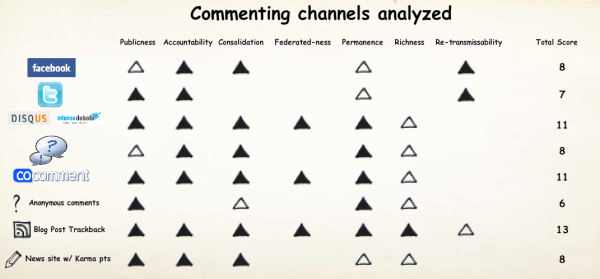Matt Asay wrote a post about a month ago and I’ve been meaning to respond. He argues that the comments section on blog posts tend to devolve into ghettos of expletives and personal attacks instead of productive discussion (I agree with this part of his post). He then proposes that Twitter is the medium we should be using to hold conversations around blog posts (this is the part I take issue with). Rather than describe at length why, here’s a graphic that summarizes the argument:
Examining what’s worked empirically
I believe commenting channels can be examined on the above seven dimensions. Admittedly there is zero science behind the above chart – this is purely subjective analysis via thinking about aspects of each medium and how they contribute to effective or ineffective discussion. In thinking about groups I’ve been involved with and which ones worked well the most interesting realization is that there’s a factor outside of the qualities of the channels themselves that trumps everything here: it’s the glue of interaction beyond the channel. The most meaningful discussions I’ve been a part of were in groups where we had in-person or real-time interaction punctuated by periods of asynchronous online exchanges. AZCFUG, CFUG manager list, Cambrian House, Refresh Phoenix, AZIPA – these are all groups that produced valuable insight and relationships, every one of them anchored by a good level of accountability through real-time interaction outside of the online channels.
When you strip everything away it’s not even the real-time aspect that’s critical though- it’s the accountability / reputation factor that ultimately drives quality discussion. When you know your words stick with you wherever you go, you behave differently. You show respect, humility, ensure what you’re typing actually adds unique value, etc. Remove this factor and you get the faceless, ghetto problem of Digg comments and the troll activity on our city’s newspaper site. You lose pride in ownership, start getting a few broken windows and the whole neighborhood adopts a license to behave badly. BUT… Twitter is not the antidote folks- starting a personal blog and supplementing it with Twitter is. Twitter alone is too short-form of a medium to communicate real substance and the “one-way follow” aspect makes it impossible to see the whole conversation as an outsider (unless people happen to be using explicit #hashtags). Yes, it addresses the accountability concern but it does so at the expense of introducing new issues of an “ADHD/Sound-byte-speak” and fragmented dialogue for the people involved. It’s like having UN delegates hold a debate where everyone can talk into their mic but nobody knows who’s hearing who because each set of headphones is tuned pickup a select fraction of the participants involved.
So what do you suggest?
The question becomes, “short of being able to have face-to-face interaction serve as an anchor of civility in discussion between online exchanges, what do you propose as the most effective means of holding productive debate online?” If you look at the above graphic you’ll understand why I believe the answer is to return to using the personal blog w/ a combination of verified comments for short responses and trackbacks for more substantive responses. Twitter has IMHO shoplifted people’s mojo and derailed this practice that used to be commonplace. I believe we’ll see Twitter fatigue and a resurgence of the way it used to be with volleys of blog posts that mutually link amongst one another. Facebook link shares and Tweets are pointers to content – like a fluid, more social RSS feed. But the real substance of discussion has always and will continue to reside in blogs.


 My friend
My friend 




